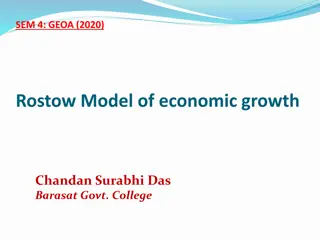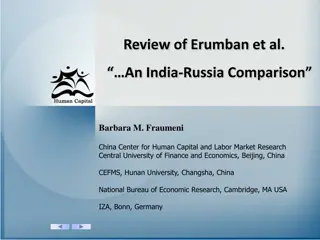Insights from Yugoslavian Economic Growth Model Analysis
This paper revisits socialist growth in Yugoslavia, focusing on model-based assessment of economic determinants and findings related to Total Factor Productivity (TFP) growth. The model decomposes output growth deviations, discussing factors like efficiency wedge, labor wedge, investment wedge, and government consumption wedge. Critiques from Christiano and Davis highlight potential complications in identifying origins of frictions. The key turning point in Yugoslav growth was the sovereign debt crisis in 1979-81, affecting credit access and investment wedge dynamics.
Download Presentation

Please find below an Image/Link to download the presentation.
The content on the website is provided AS IS for your information and personal use only. It may not be sold, licensed, or shared on other websites without obtaining consent from the author.If you encounter any issues during the download, it is possible that the publisher has removed the file from their server.
You are allowed to download the files provided on this website for personal or commercial use, subject to the condition that they are used lawfully. All files are the property of their respective owners.
The content on the website is provided AS IS for your information and personal use only. It may not be sold, licensed, or shared on other websites without obtaining consent from the author.
E N D
Presentation Transcript
Comments on Socialist Growth Revisted: Insights from Yugoslavia Evan Kraft American University YES Conference, Dubrovnik June 2015
Contributions of the paper Model-based assessment of determinants of Yugoslavia s economic growth Brings up to date older growth-accounting work such as Sapir (1980) In line with recent literature reflecting on Communist economies ability to sustain fairly rapid growth for a certain period of time (eg. Broadberry and Klein 2011 for Czechoslovakia) Potential contribution to understanding role of economic institutions
Findings of the paper TFP growth accounts for increasing share of growth over time Growth slowdown after 1979 mainly due to labor wedge
The model: Chari, Kehoe and McGrattan (2007) Decompose deviations of output growth from trend into four frictions: Efficiency wedge (time-varying TFP growth) Labor wedge (labor income tax) Investment wedge (investment tax) Government consumption wedge (government consumption and net exports) in this paper called Income wedge Argument is that factors affecting growth can be bunched into these categories for further analysis Acknowledge that these are reduced forms, so that the wedges are not representations of the underlying model. Example: an economy with sticky wages and monetary shocks maps into a growth model with labor wedges.
Christiano and Davis (2006): critique Show that wedges may not be independent Credit market imperfections that generate investment frictions may also increase labor wedges, for example If so, identification of origins of frictions is unclear Also, the form of the friction may matter Get very different results for an ROE tax rather than a direct tax on investment. In the case of the US Great Depression, credit market frictions of this form, a la Bernanke, Gertler and Gilchrist, can explain a great deal of output variation, while the direct tax formulation used by Chari et al does not explain much output variation (My own comment growth really is not endogenous in this approach. The trend rate of growth of labor augmented productivity growth is a fixed parameter. Only wedges can change)
What happened to Yugoslav growth? Key turning point: 1979-81 Economic event: sovereign debt crisis How should this show up in the model? Obvious effect should be difficulty accessing credit investment wedge? Research by Vodopivec (1989) and Kraft and Vodopivec (1992) shows large importance of soft-budget finance through Discretionary tax and subsidy policies Inflationary gains and losses, reaching great importance as inflation rises in the 80 s Regional redistribution enterprises in Slovenia are net payers, all others net receivers, with receipts correlated with income per capita
What reforms were undertaken after 1979? Few systemic reforms until 1988 Initial austerity, export at all costs mentality (potentially decreasing efficiency) Policy vacillation Sharp decrease in personal incomes, rise in unemployment, rise in inflation Increase in labor unrest, especially in the second half of the 1980 s, but not clear how much effect this had on output How should this show up in growth accounting?
Periods and breakpoints Several other years could perhaps be examined as breakpoints 1961: end of grant funding from West 1965: major economic reform, including major effects on labor supply (freedom to travel leads to outmigration) and labor demand (greater decision-making power for companies probably decreases labor demand). 1971: reaction against reform, beginning of new self-management agreement period 1974: new Constitution 1976: Law on Associated Labor major new labor code Could be worthwhile to examine these sub-periods Also, 1970 s are critical Failure to adjust to energy shocks Increasing foreign debt Similar to Poland more than Czechoslovakia
Labor market distortion: history Firms were labor managed for the whole period under study Open unemployment is seen from the mid-1960s at least Self-management agreements created detailed wage determination structures in 1970s Set by bargaining process But strong Communist Party influence, pressure to limit wage disparities One would think that distortions would have increased substantially when this system was introduced in the mid-1970s But in the 1980 s, firms were required to increase hiring based on numbers given in Republic-level self-management agreements Would this account for labor wedge? Some deeper digging here could be very helpful.
Regional issues Aggregate data may be misleading in a country where GDP/capita in the most advanced republic was 7-8 times that in the least advanced autonomous region Productivity differences associated with skill may vary: a PhD in the more advanced regions may be substantially more productivity- enhancing compared to secondary education than a PhD in the less- developed regions In other words, returns to schooling may have varied considerably across Yugoslavia This could pose issues for the conversion of educational attainment into Mincerian human capital
To what extent was Yugoslavia a market economy, and how does this affect modeling? Government involvement in investment decisions decreased after 1965 central General Investment Fund closed But Republic level influence remained strong, perhaps underplayed in paper Major projects clearly decided on non-economic basis by Government Belgrade-Bar railroad Aluminum, steel factories in each Republic held up as major new source of inefficiency post 1971 Can we distinguish between Inefficient investment decisions taken directly by Government--policy Tax/regulatory frictions--system Influence of worker-management--ownership?
Potential payoff: different story Broadberry and Kline, along with many others, point to inability of socialist systems to make transition from extensive to intensive growth But Yugoslav case shows inability to continue technological imitation Part of this is macro-level inability to manage foreign borrowing (a common story in the 1970 s) Part of this is micro-level inefficiencies (labor and capital allocation mechanisms)























